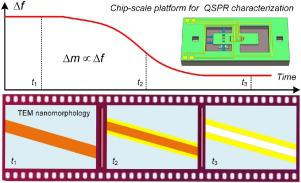当前位置:
X-MOL 学术
›
Nano Today
›
论文详情
Our official English website, www.x-mol.net, welcomes your feedback! (Note: you will need to create a separate account there.)
An in-situ TEM microreactor for real-time nanomorphology & physicochemical parameters interrelated characterization
Nano Today ( IF 17.4 ) Pub Date : 2020-12-01 , DOI: 10.1016/j.nantod.2020.100932 Wei Li , Ming Li , Xueqing Wang , Pengcheng Xu , Haitao Yu , Xinxin Li
Nano Today ( IF 17.4 ) Pub Date : 2020-12-01 , DOI: 10.1016/j.nantod.2020.100932 Wei Li , Ming Li , Xueqing Wang , Pengcheng Xu , Haitao Yu , Xinxin Li

|
Abstract In-situ quantitative structure-property relationship (QSPR) characterization between nanomorphology and physicochemical parameters is essential for revealing the growth mechanism and guiding the optimization of functional nanomaterials. However, extracting the interrelated physicochemical parameters in the process of nanomorphology observation is still challenging. Herein, this paper demonstrates an advanced chip-scale platform for in-situ QSPR characterization by integrating a gravimetric resonant microcantilever sensor within a transmission electron microscopy (TEM) microreactor. The microcantilever measures the thermodynamic and kinetic parameters, such as enthalpy (ΔH°), activation energy (Ea) and reaction rate (v), by monitoring the reaction-induced mass change of functional nanomaterials. Simultaneously, the low-stress SiNx films as electron transparent windows allow in-situ nanomorphology observation. Using such a QSPR characterization platform, the three-stage sulfuration mechanism based on nano Kirkendall effect for the gas-solid reaction of H2S and Cu nanowires is revealed, and the different molecule-interaction behaviors of SO2 on ZnO nanowires at various temperatures are distinguished for the first time. It is believed that the in-situ QSPR microreactor can be widely used for elucidating the underlying interfacial thermodynamic/kinetic reaction mechanism, and guiding the controllable synthesis and precise optimization of functional nanomaterials.
中文翻译:

用于实时纳米形态学和物理化学参数相关表征的原位 TEM 微反应器
摘要 纳米形态学和物理化学参数之间的原位定量结构-性能关系(QSPR)表征对于揭示生长机制和指导功能纳米材料的优化至关重要。然而,在纳米形态观察过程中提取相互关联的理化参数仍然具有挑战性。在此,本文通过在透射电子显微镜 (TEM) 微反应器中集成重力共振微悬臂梁传感器,展示了一种用于原位 QSPR 表征的先进芯片级平台。微悬臂梁通过监测功能纳米材料的反应引起的质量变化来测量热力学和动力学参数,例如焓 (ΔH°)、活化能 (Ea) 和反应速率 (v)。同时地,作为电子透明窗口的低应力 SiNx 薄膜允许原位纳米形态观察。利用这样的 QSPR 表征平台,揭示了基于纳米柯肯德尔效应的 H2S 和 Cu 纳米线气固反应的三阶段硫化机理,并区分了不同温度下 SO2 对 ZnO 纳米线的不同分子相互作用行为第一次。相信原位QSPR微反应器可广泛用于阐明潜在的界面热力学/动力学反应机理,指导功能纳米材料的可控合成和精确优化。揭示了基于纳米柯肯德尔效应的硫化氢与铜纳米线气固反应的三级硫化机理,首次区分了不同温度下 SO2 对 ZnO 纳米线的不同分子相互作用行为。相信原位QSPR微反应器可广泛用于阐明潜在的界面热力学/动力学反应机理,指导功能纳米材料的可控合成和精确优化。揭示了基于纳米柯肯德尔效应的硫化氢与铜纳米线气固反应的三级硫化机理,首次区分了不同温度下 SO2 对 ZnO 纳米线的不同分子相互作用行为。相信原位QSPR微反应器可广泛用于阐明潜在的界面热力学/动力学反应机理,指导功能纳米材料的可控合成和精确优化。
更新日期:2020-12-01
中文翻译:

用于实时纳米形态学和物理化学参数相关表征的原位 TEM 微反应器
摘要 纳米形态学和物理化学参数之间的原位定量结构-性能关系(QSPR)表征对于揭示生长机制和指导功能纳米材料的优化至关重要。然而,在纳米形态观察过程中提取相互关联的理化参数仍然具有挑战性。在此,本文通过在透射电子显微镜 (TEM) 微反应器中集成重力共振微悬臂梁传感器,展示了一种用于原位 QSPR 表征的先进芯片级平台。微悬臂梁通过监测功能纳米材料的反应引起的质量变化来测量热力学和动力学参数,例如焓 (ΔH°)、活化能 (Ea) 和反应速率 (v)。同时地,作为电子透明窗口的低应力 SiNx 薄膜允许原位纳米形态观察。利用这样的 QSPR 表征平台,揭示了基于纳米柯肯德尔效应的 H2S 和 Cu 纳米线气固反应的三阶段硫化机理,并区分了不同温度下 SO2 对 ZnO 纳米线的不同分子相互作用行为第一次。相信原位QSPR微反应器可广泛用于阐明潜在的界面热力学/动力学反应机理,指导功能纳米材料的可控合成和精确优化。揭示了基于纳米柯肯德尔效应的硫化氢与铜纳米线气固反应的三级硫化机理,首次区分了不同温度下 SO2 对 ZnO 纳米线的不同分子相互作用行为。相信原位QSPR微反应器可广泛用于阐明潜在的界面热力学/动力学反应机理,指导功能纳米材料的可控合成和精确优化。揭示了基于纳米柯肯德尔效应的硫化氢与铜纳米线气固反应的三级硫化机理,首次区分了不同温度下 SO2 对 ZnO 纳米线的不同分子相互作用行为。相信原位QSPR微反应器可广泛用于阐明潜在的界面热力学/动力学反应机理,指导功能纳米材料的可控合成和精确优化。


























 京公网安备 11010802027423号
京公网安备 11010802027423号